
Figure 1. The path of the Sun, the ecliptic, shown relative to the background stars and the Celestial Equator (dec=0). The location of the Sun on the equinoxes and solstices is indicated. Some declination values are also indicated.
Now for the rest of the year, the Sun's path and its rising and setting locations vary. As seen from Iowa, during the winter the Sun rises in the southeast and sets in the southwest. In the summer it rises in the northeast and sets in the northwest. There are two days when the rising and setting locations are at their most extreme (furthest north or furthest south). These days are also the dates that the Sun travels a path that is also an extreme - very long and high above the horizon or very short and low to the horizon. These are the days known as the Winter Solstice, which occurs around December 21 (shortest day), while the other is called, oddly enough, the Summer Solstice, and it occurs around June 21. Of course, you know these days as the beginning of Winter and Summer. Like the dates of Equinoxes, they have really nothing to do with the weather, but with the position of the Sun relative to the Celestial Equator.
One thing you have to remember about the Sun is that it makes it very difficult to see anything else in the sky when it is out - even though the stars and planets are out there, the brightness of the Sun is so overwhelming that you don't have much of a chance of see them until the Sun sets. Which stars would be visible? Which constellations would be visible if we could turn off the Sun? That depends upon what time of the year you look. If you were to turn the Sun down so that you could see the stars at the same time that you could see the Sun, you would notice that the Sun appears to move slowly toward the East from one day to the next - it moves about 1º each day. In about a month it has moved 30º to the East relative to the stars; in four months, it will be about 120º east of where it started; and after one year, it will have gone about 360º. That means it is back where it started from, since there are 360º in a circle! This also explains why we see different constellations in different seasons. As the Sun moves slowly in front of various constellations, those constellations are no longer visible since they are too close to the Sun, but constellations far from them are visible, since they will be visible when the Sun has set or before it rises. Since the Sun appears to move relative to these stars, it will gradually cover up other stars, and other stars that were previously not visible will again be viewable as the Sun gets further away from them.
Actually, the folks in the old days could figure out where the Sun
would be relative to the stars by looking at the stars which were
visible when the Sun set. They knew which constellations the Sun covered
up and when they were covered up (which time of the year they were or
were not visible). If you were to map out the path of the Sun relative
to the stars, you would see it as a curved line on the Celestial Sphere.
Take a look at Figure 1 to see the path relative to the Celestial
Equator. This image is of a flattened out Celestial Sphere, and the
dates mark the locations of the Sun relative to the stars over the
course of the year.

Figure 1. The path of the Sun, the ecliptic, shown relative to
the background stars and the Celestial Equator (dec=0). The location of
the Sun on the equinoxes and solstices is indicated. Some declination
values are also indicated.
As is apparent, the path of the Sun is curved relative to the Celestial Equator. There are times during the year when it is north of the Celestial Equator and other times when it is south of it. The declination of the Sun varies throughout the year. (Of course, its R. A. changes as well, becoming slowly larger each day as the Sun moves eastward relative to the stars, but we'll pay more attention to the declination). On the days of the Equinoxes, the Sun is right on the Celestial Equator, so it has a declination of 0º, and on the Solstices, it has the most extreme value for its declination, 23.5º N on the date of the Summer Solstice and 23.5º S on the Winter Solstice. The Solstice dates mark when the Sun is at its greatest distance from the Celestial Equator.
The path the Sun appears to make amongst the stars is known as the ecliptic. Just like the Celestial Equator, it would make a large circle on the Celestial Sphere. In fact the ecliptic is a big circle that is tilted 23.5º relative to the circle made by the Celestial equator. This is shown in Figure 2.
 Figure 2. The location
of the Ecliptic on the Celestial Sphere.
Figure 2. The location
of the Ecliptic on the Celestial Sphere.
Why is it like this? Why does the Sun travel on its own unusual path? Here is where I get to shatter all of your delusions - there is no Santa Claus! Oh, wait, that wasn't the delusion I was supposed to shatter. No, the concept I get to confuse you with is concerning all these motions I have described so far.
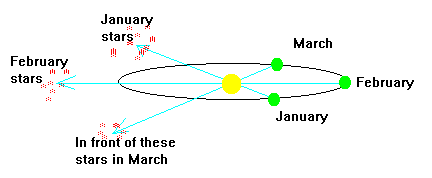 Figure 3. The apparent motion of the Sun amongst the
stars is due to the motion of the Earth around the Sun and our changing
viewpoint. The stars that we would see behind the Sun in January would
be different from the stars we would see behind the Sun in February,
March, and every other month, since we are changing the location from
which we view the Sun.
Figure 3. The apparent motion of the Sun amongst the
stars is due to the motion of the Earth around the Sun and our changing
viewpoint. The stars that we would see behind the Sun in January would
be different from the stars we would see behind the Sun in February,
March, and every other month, since we are changing the location from
which we view the Sun.Since the Earth is tilted, there are times when the tilt has the Sun located north of the Celestial Equator and other times when the Sun is located south of the Celestial Equator. If the Earth were not tilted then the Sun would be always located on the Celestial Equator - which would be pretty boring. The angle of the tilt, 23.5º, is an important number (remember seeing it in values for the Sun's declination?). Just stay tuned, you'll see it again.
The Earth is tilted over; is that such a big deal? You're darn right it is, because without this tilt, there would be no seasons. As the Earth goes around the Sun, the tilt of the Earth causes different parts of the Earth to receive different amounts of sunlight. During the months of May, June and July, the northern hemisphere of the Earth is tilted more toward the Earth than the southern hemisphere. That gives the northern hemisphere a greater amount of heat and results in higher temperatures and more sunburns. The opposite is true during November, December and January, when the Northern hemisphere is tilted away from the Sun. Check out Figure 4 to see the situation.
 Figure 4. The tilt of the Earth and its motion
around the Sun make it appear as if the Sun is going further to the
north (north of the Celestial Equator) or south (south of the Celestial
Equator) over the course of a year.
Figure 4. The tilt of the Earth and its motion
around the Sun make it appear as if the Sun is going further to the
north (north of the Celestial Equator) or south (south of the Celestial
Equator) over the course of a year.
Here is an animated image showing how the surface of the Earth gets different amounts of sunlight depending upon the time of year and the latitude. Each image is taken about one week apart at the same time of day, and since the curved surface of the Earth is flattened down in the image the lighting pattern is rather strangely shaped. You should pay careful attention to the date of each image and how some parts of the Earth are in total darkness some times during the course of the year (the polar regions). If you want to see how the sunlight falls on the surface of the Earth over the course of a single day, just click here. In this case, the images are about one hour apart.
On the Summer and the Winter Solstice (around June 21 and December 21 respectively), the Sun reaches its most northern and southern declinations. People who live at a latitude of 23.5º north and south of the equator will have the Sun at their zenith at noon only on that day of the year (June 21 or December 21 depending upon whether they live at 23.5º north or south). You may have noticed these latitudes marked on maps because of their special relation to the Sun - these are the Tropics. They are the Tropic of Capricorn, located at 23.5º S, when the Sun is at the zenith on about December 21, and the Tropic of Cancer, found at a latitude of 23.5º N, where the Sun is found at the zenith on about June 21.
These two lines also limit the locations where the Sun is visible at the zenith. Only between the latitudes of 23.5º N and 23.5º S would you ever have the Sun directly overhead. Since the declination system is an extension of the latitude system, the Sun's declination can only have values within that range as well, between 23.5º N and 23.5º S.
Here is an animation of the Sun relative to the stars. Each image is seven days apart so that you are seeing how far the Sun moves in a week's time relative to the stars. You'll see that it moves toward the left (East), and sometimes it goes further to the south and sometimes it goes further to the north. These are the stars and constellations that the Sun would appear to be in front of at some time during the year, if we could see the stars located behind the Sun in the daytime. You may notice that many of the constellation names are familiar to you; gee, I wonder from where?
We have the Sun appearing to move amongst the stars (but you know that it is really due to the motion of the Earth around the Sun) along the ecliptic. This path, the ecliptic, goes through various constellations in the sky. In fact, it goes roughly through 12 rather special constellations. These constellations are sort of set apart from the rest of the constellations because of this aspect and we refer to them as the zodiac. This brings up a rather interesting aspect of astrology - determining what your "sign" is. If you were to look in a newspaper at a horoscope column, you can determine what your "sign" is by the date of your birth. What does the date have to do with it? The date is supposed to correspond to the location of the Sun relative to the stars on the day you were born. Since the Sun appears to move, the stars it is in front of will change gradually over the course of a year. Whatever constellation (of the zodiac) the Sun was in front of on the day you were born will tell you what your "sign" is. This may seem like a straightforward explanation, but it is not very correct.
If you were born today, what would your sign be? This should be the constellation that the sun is located in today. If the date is August 30, then a person born today would be of the "sign" Virgo, at least according to what it says in the paper. That means the Sun is in front of the stars of the constellation of Virgo on August 30. Is it? If you were to go to the star charts and check, you'd find that the Sun is in the constellation of Leo, not Virgo. In fact, it won't be in Virgo for some time. By the time it is in Virgo, the astrology columns in the newspaper say that the Sun is supposed to be in Libra. The Sun is not in the constellation that corresponds to the dates of the horoscope signs. The Sun is usually located in the previous "sign's" constellation. All of the signs are off by one. All that time you thought you were a Scorpio, you were actually born under the sign of Libra - of course, if you believe any of that astrology crap to begin with, you're in more trouble than I can believe.
Why is the system all screwed up? Is this any way to do business? Of course it is not, and to be honest, the system was originally set up correctly. When this system was initially set up, the Sun was in the correct "sign," so that on August 30, the Sun was in the constellation of Virgo (unlike how it is now). Things have changed since the astrological signs were first set up by the Babylonians in about 2000 BC. The entire system has been gradually shifting due to the wobbling of the Earth. The Earth is wobbling? Yes, the Earth sort of acts like a spinning top - and like a spinning top, it wobbles. We shouldn't say wobbles, since that doesn't sound too scientific. The term precession is used to describe the wobbling - and it does sound more scientific. The Earth is slowly precessing, and the pole of the Earth, or the axis of rotation, will point one way, then another, then back again and so on, just like a wobbling toy top. This is mainly due to the Moon's gravitational influence.
Originally, on the Vernal Equinox in 2000 BC, the Sun was located in between Aries and Pisces, so for the next month everyone should be an Aries (March 21 - April 21). Due to the Earth's precession, the Earth has wobbled so much that the celestial poles and equator are aligned with different parts of the sky. Things got screwed up, since the location of the celestial equator defines the location in the sky where the equinoxes occur. Now, on the Vernal Equinox, the Sun is not at the same location relative to the stars it was in when the system was set up. It's actually in Pisces and getting closer to Aquarius - which, by the way, is sort of the basis for that song "Age of Aquarius," but you might be too young to remember that golden oldie. The beginnings of the seasons have also slowly changed relative to the stars, since the equinoxes mark these. It used to be that the first day of spring occurred when the Sun was in front of the stars of Aries; now it occurs when the Sun is in front of the stars of Pisces.
I've provided links to YouTube movies that show how the changing orientation of the Earth's poles changes the coordinates. The movie shows how the location of the celestial equator and pole changes over time, from the past and well into the future. The celestial equator and the ecliptic define the seasons and the point where the Sun is located on the first day of spring is noted. You'll see how this location appears to change over time. The second part of the movie shows in more detail how the North Celestial Pole changes its apparent location over time so that at some times there isn't an actual North Star, and in the past and future there will be different North Stars (other than Polaris). We're actually kind of lucky to have the current star at that location now, since for most of the time there isn't a very bright star near the North Celestial Pole. While it takes a long time to make the shift of these things noticeable, it was known to ancient astronomers, though of course they didn't know the cause. Nowadays if we want to point our telescopes with very precise coordinates we have to calculate the effects of precession on the coordinates - which is pretty small from year to year, but is important if you want very precise coordinates.
The tilt of the Earth doesn't change much (currently at 23.5º ), but the direction that the pole points changes. The North pole star (Polaris) will not be there all the time - in a few hundred years the current north star will be just another star in the northern sky, since it will not be located at the North Celestial Pole. In the past, other stars would have been called the Pole star, since they were closer to the North Celestial Pole than Polaris was. During your life time, Polaris will be the North Star, since the wobbling is pretty slow. One precession takes about 26,000 years. Figure 5 shows a simplified view of the precession of the Earth.
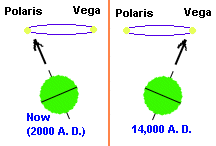 Figure
5. The direction that the Earth's pole points changes slowly so
that in the far future it will be pointing to stars such as Alderamin,
Vega, Thuban, and eventually again Polaris.
Figure
5. The direction that the Earth's pole points changes slowly so
that in the far future it will be pointing to stars such as Alderamin,
Vega, Thuban, and eventually again Polaris.
Why is there a difference between a Solar day and a Sidereal day? The cause is the motion of the Earth, in this case our orbital motion around the Sun. To illustrate what's going on, follow the stick in Figure 6. It starts out one day pointing directly at the Sun (at noon) and at a very distant star (a star way off to the right).
 Figure 6.
The time it takes for a position on the
Earth to line up with a distant star (way off to the right) is 23 hours
and 56 minutes. However, the Sun will not be lined up with the position
on the Earth, and an additional four minutes are needed.
Figure 6.
The time it takes for a position on the
Earth to line up with a distant star (way off to the right) is 23 hours
and 56 minutes. However, the Sun will not be lined up with the position
on the Earth, and an additional four minutes are needed.
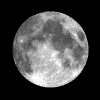 The phases occur in a
very predictable sequence. Here is the order of the phases - New (when
you can't see the Moon - it's all dark), Waxing Crescent, First Quarter
(when you see the right half lit), Waxing Gibbous, Full (when you see
the entire lit surface), Waning Gibbous, Third Quarter - also called Last
Quarter (when you see the
left side lit up), Waning Crescent, and back to where we started, New.
A picture of the phases is shown in Figure 7. It takes about one week
to go from one major phase to the next - by major phase I mean New, the
Quarters and Full. If the Moon is New today, it will be a First Quarter
Moon in about one week, and a full Moon two weeks from today. The fact
that it takes about 29.5 days to go through the cycle is the reason
there are about 30 days in a month, since many ancient societies used
the Moon as a time keeper.
The phases occur in a
very predictable sequence. Here is the order of the phases - New (when
you can't see the Moon - it's all dark), Waxing Crescent, First Quarter
(when you see the right half lit), Waxing Gibbous, Full (when you see
the entire lit surface), Waning Gibbous, Third Quarter - also called Last
Quarter (when you see the
left side lit up), Waning Crescent, and back to where we started, New.
A picture of the phases is shown in Figure 7. It takes about one week
to go from one major phase to the next - by major phase I mean New, the
Quarters and Full. If the Moon is New today, it will be a First Quarter
Moon in about one week, and a full Moon two weeks from today. The fact
that it takes about 29.5 days to go through the cycle is the reason
there are about 30 days in a month, since many ancient societies used
the Moon as a time keeper.

Figure 7. The phases of the Moon as seen from Iowa when the
Moon is high in the sky (on your meridian).
What causes the phases? To figure that out, you need to look at the interaction of the light source (Sun) and the alignment of the Moon with the Earth. The Moon will have a certain phase depending upon two things -
The Quarter Moons occur when the Sun and the Moon are 90º degrees apart in the sky as viewed from the Earth. The New and Full phases occur during times when the Earth, Moon and Sun are in a straight line. Figure 8 is a composite of the various phases and the location of the Moon in the sky. Remember, it takes about a week for the Moon to go from one major phase to the next, so that the view you see during one evening isn't too much different from the view you see the next night. You may have seen the Moon when it is close to the Full phase and it may appear to you to be Full for several days, while technically it is only Full at the time it is in a line with the Earth and the Sun. Also, the way that the Moon is illuminated gives us the view we see - when most of the lit surface is turned away from the Earth, we see only a small crescent; when most of the surface is turned toward the Earth, we see the gibbous phase Moon.
Here is a little java program showing just one phase at a time. You can see how the Moon looks to you in the sky depending upon where it is located in its orbit about the Earth.
 Figure 8.
The phases of the Moon shown at their
locations relative to the position of the Earth and the Sun (off to the
right). The phase of the Moon is determined by its location relative to
the Earth and Sun. The right side of the Moon is the only part that is
illuminated, since the Sun is off to the right. The phase that we see
depends upon how much of that side of the Moon is visible from the
Earth, which depends upon where the Moon is in its orbit about the Earth.
Figure 8.
The phases of the Moon shown at their
locations relative to the position of the Earth and the Sun (off to the
right). The phase of the Moon is determined by its location relative to
the Earth and Sun. The right side of the Moon is the only part that is
illuminated, since the Sun is off to the right. The phase that we see
depends upon how much of that side of the Moon is visible from the
Earth, which depends upon where the Moon is in its orbit about the Earth.
At what time of day does the Moon rise and set? When does it cross your meridian (this is another way of asking "When is it highest in the sky?")? Well, that will depend on the phase. The phase will determine the location of the Moon relative to the Sun. Your location relative to the Sun will determine what time of day it is. Remember, we base our time system upon the location of the Sun - so if the Sun is on your meridian (high in the sky), then it is Noon at the part of the Earth you are located at. A person at a location on the opposite side of the Earth from you would be looking at their watch and noting that it is midnight. Of course, daylight savings time, and the rather irregular way that time zones are set up, may actually mean that it is not exactly noon or midnight, but we'll make it simple and assume that it is.
Take a look at the set up shown in Figure 9. If you were at the point labeled "noon," the Sun would be high in the sky, but the Moon would be on the horizon - it would be rising. If you were located at the location labeled 6 PM, the Moon would be high in the sky, and the Sun would be on the horizon; in this case, this is also referred to as the time of sunset. A person at the midnight position would see the Moon on the horizon, setting. Remember, as viewed from above the North pole, all motions are counter-clockwise. The Earth will be spinning around while the Moon remains in about the same position (the first quarter phase location). All day, anyone seeing the Moon would see a First Quarter moon. To see the Moon you must be located on the side of the Earth that is toward the Moon, so the person located at the 6 AM spot wouldn't see the First Quarter Moon, and neither would anyone located at a position corresponding to 1 AM, 2 AM, 3 AM... all the way until Noon. It would take a day or two for there to be a noticeable change in the Moon's rising and setting times.
Follow this link to see a little java program showing how the different phases of the Moon would appear to an observer, when they would be seeing them and what the Moon would be doing. You can also change the location of the observer to get different times of day.
 Figure 9. The
location of the First Quarter Moon allows you to determine when it rises
(noon), sets (midnight) and when it is high overhead (6 P.M.).
Figure 9. The
location of the First Quarter Moon allows you to determine when it rises
(noon), sets (midnight) and when it is high overhead (6 P.M.).
In diagrams like Figure 9, you would first have to put the Moon in the appropriate location relative to the Sun and the Earth for its current phase, then what you see depends upon where on the Earth you are, and your time depends upon where you are relative to the Sun. A few basic rules to follow for the Moon-rising-setting problems -
1. New Moon is in line with the Sun, so it does everything exactly when the Sun does its stuff - rises at 6 AM, sets at 6 PM, and on the meridian at Noon.Follow this link to see a little java program that quizzes you about the what the Moon is doing depending upon the set up. You can determine the answer or just keep guessing until the program tells you the answer. Either way, you'll eventually get the correct answer and a diagram showing you the set up.
How long does it take the Moon to orbit once around the Earth? It takes about 27.3 days. Why not 29.5 days (the time for the phase cycle)?
Again, it has to do with the fact that the Earth is moving around
the Sun. Take a peak at Figure 10. It shows the variation from one Full
moon to the next. Remember, the Moon has to be in a straight line with
the Earth and Sun for it to be Full. It starts out lined up with the
Sun, but after 27.3 days, the Moon will have made one complete orbit of
the Earth (again be located to the left of the Earth). At this time is
it Full? No, because it is not in a perfect line with the Sun. You have
to wait about 2 more days for it to again be aligned with the Sun and
for it to be Full again.
If you spend a couple of days watching the Moon relative to the stars you'd see that it moves about 12 degrees each night (since it has to go 360 degrees in about 30 days). You may not notice the motion of the Moon relative to the stars over the course of an evening since it is sometimes difficult to see the stars close to the Moon, but you can certainly note the fact that each night it rises about 50 minutes than the previous night, so the Moon's position relative to the stars has changed.
 Figure 10. The Moon
makes one complete orbit of the Earth in 27.3 days, but it will not be
again Full until a total of 29.5 days has passed.
Figure 10. The Moon
makes one complete orbit of the Earth in 27.3 days, but it will not be
again Full until a total of 29.5 days has passed.
One orbit of the Moon takes 27.3 Days. This would be the Moon's Sidereal Period since it is the time for the Moon to be back in the same location relative to the stars, and this is also the time for one orbit. How long does it take for one rotation (spin) on its axis? Does the Moon actually spin on its axis? If you said "no," then you're wrong. The Moon does spin on its axis, but it does it in 27.3 days. That's the same amount of time for one orbit - what does that mean? It means that one side of the Moon always faces the Earth - that the Moon has one side tidally locked with the Earth.
If you still think that the Moon doesn't spin around think about this - if it didn't, we'd see different sides of the Moon, not just always the same view. This is shown in Figure 11. If the Moon did not rotate, it would always have one side pointing in the same direction, as is shown by a line on it. That line would always be pointing in the same direction in space, but on the Earth we would see different sides of the Moon as it goes around the Earth. That's not what we see - we can only see one side of the Moon from the Earth, since that one side is always pointing toward us.
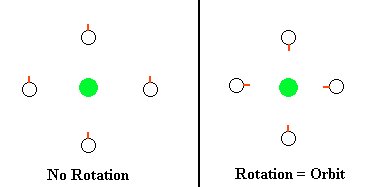 Figure 11.
The Moon makes one complete orbit in the
same amount of time it takes to make one rotation. If it didn't rotate,
we'd have the situation on the left, where different sides of the Moon
would be visible from the Earth as it goes around the Earth. One side of
the Moon is always facing the Earth, since the orbital period is the
same as the rotation period.
Figure 11.
The Moon makes one complete orbit in the
same amount of time it takes to make one rotation. If it didn't rotate,
we'd have the situation on the left, where different sides of the Moon
would be visible from the Earth as it goes around the Earth. One side of
the Moon is always facing the Earth, since the orbital period is the
same as the rotation period.
The time for it to complete a cycle of phases is 29.5 days. I don't think we can just call it that, can we? No, of course not; we'll have to give it a more "scientific name." We refer to this time as the Synodic Period. This is just the time it takes for the same Earth-Sun-Moon alignments to occur again, so it is the time for the Moon to go from one Full Moon to the next Full Moon, or the time it takes to go from one first quarter moon to the next first quarter moon - either way, it is 29.5 days.
You may have noticed that I used the phrase "tidally locked" above. What's that all about? Living in Iowa, you are probably not too familiar with the phenomena of tides, and just to be clear, I'm not referring to laundry detergent - what I'm talking about is how the Moon and the Earth pull upon one another and how the consequences of those "pulls" are predictable. Tides usually refer to the water levels of large bodies of water like the oceans which change near the shore due to the pull of the Moon (and the Sun) on the water. While we haven't gotten to gravity yet, you can at least appreciate the fact that a large nearby object like the Moon has a pretty good gravitational influence on the Earth - it is pulling on the Earth all the time, but the only thing that we see responding to the pull is the water. This gravitational pull causes a bulge in the water in the oceans. This bulge follows the motion of the Moon.
The bulges actually occur on both sides of the Earth. The side that's closest to the Moon feels the strongest pull and bulges out, and the side furthest from the Moon feels a lesser pull and is sort of left behind (since the center of the Earth also feels the pull, more than the water on the furthest side of the Earth). This is shown in Figure 12.
 Figure 12.
The Moon's pull on the water and the Earth
produces bulges on the two sides of the Earth. The degree of the pull is
shown by the arrows, with the side nearer the Moon having the largest
pull, and the side further having the smallest pull.
Figure 12.
The Moon's pull on the water and the Earth
produces bulges on the two sides of the Earth. The degree of the pull is
shown by the arrows, with the side nearer the Moon having the largest
pull, and the side further having the smallest pull.
Since it takes only 23 hours and 56 minutes for the Earth to rotate, coastal locations will pass through the high water bulges (have high tides) two times each day. Remember, the motion of the Moon is much slower, so the Earth actually rotates through the tides.
The Sun also has an influence on the tides, but since it is further away, it doesn't pull as strongly. However, when both the Moon and the Sun are pulling along the same axis, the tides are highest. These tides are known as spring tides, and they have nothing to do with Spring, but they occur when the Moon is either Full or New. When the Moon and Sun are 90 degrees apart from one another (during the Quarter phases) the tides are flattened out - these are the neap tides. Tides are very important for coastal regions, since in some places, you can't get a ship out of the harbor if the water level is too low. A storm that occurs during high tide could cause coastal flooding (this is often seen during hurricanes). Knowing when the high tides occur is very important for many places for a variety of reasons.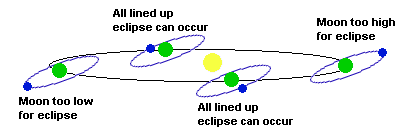 Figure 13. The tilt of
the Moon's orbit means that most of the time it isn't lined up for an
eclipse to occur.
Figure 13. The tilt of
the Moon's orbit means that most of the time it isn't lined up for an
eclipse to occur.
Is the Moon entirely dark during a lunar eclipse? No, you can still see it, though it is dimmed and often colored. Why? The Earth has an atmosphere which tends to bend light around the Earth, and this falls upon the Moon. The light does get discolored, though; often a red, orange or brown color is seen. This really scared the heck out of folks in the old days when they didn't know what was going on, which was most of the time.
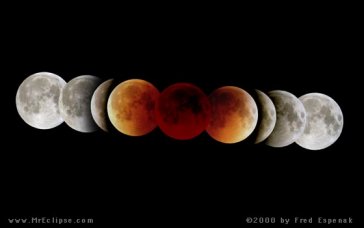 Figure 14.
A multiple exposure image of a lunar
eclipse. When the eclipse first starts out the brightness of the Moon is
so great that only short exposures are used. The umbra, which is the
darkest part of the shadow, doesn't appear to have any color in these
images. Only at mid-eclipse is the Moon darkened enough so that the
color of the umbra is visible. Eclipse photograph copyright
2000 by Fred Espenak courtesy of www.MrEclipse.com.
Figure 14.
A multiple exposure image of a lunar
eclipse. When the eclipse first starts out the brightness of the Moon is
so great that only short exposures are used. The umbra, which is the
darkest part of the shadow, doesn't appear to have any color in these
images. Only at mid-eclipse is the Moon darkened enough so that the
color of the umbra is visible. Eclipse photograph copyright
2000 by Fred Espenak courtesy of www.MrEclipse.com.
 Figure 15. The
shadows, umbra and penumbra, cast by the Earth during a lunar eclipse.
The Moon is experiencing a total lunar eclipse here since it is in the
umbra - the darkest shadow.
Figure 15. The
shadows, umbra and penumbra, cast by the Earth during a lunar eclipse.
The Moon is experiencing a total lunar eclipse here since it is in the
umbra - the darkest shadow.
Lunar eclipses can be full - the Moon passes completely through the Earth's umbral shadow, partial - it passes only through part of the umbral shadow, or penumbral - it only passes through the penumbra. The best are of course the full eclipses, which can last for hours as the Moon traverses the entire length of the umbral shadow, while the least exciting are the penumbral eclipses, which are really difficult to see since the sunlight that falls on the Moon's surface is so bright to begin with. Here is a table of lunar eclipses that will be occurring over the next few years - some of which are visible from Iowa. Here is a time lapse movie showing how the April 2015 lunar eclipse looked (in case you missed it). The actual eclipse took much longer than the video, and one of the problems with getting pictures of lunar eclipses is the change in brightness of the Moon. Before the eclipse it can be very bright, while during the eclipse the Moon may actually be very difficult to see.
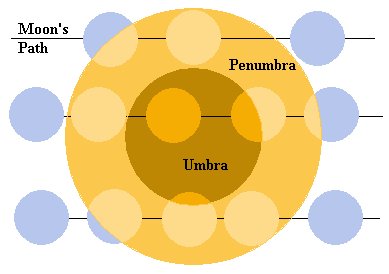 Figure 16.
The shadows, umbra and penumbra, cast by
the Earth during a lunar eclipse are seen as circles here. The shadows
that the Earth casts look like circles, since it is a sphere. The Moon's
path is shown for the three different types of lunar eclipses. The top
path is for a penumbral eclipse, where the Moon never passes into the
umbra, but is only in the penumbral shadow. The central path shows a
total lunar eclipse, where the Moon passes entirely through the umbral
shadow. The bottom path is for a partial eclipse, where only a part of
the Moon's shadow goes into the umbra. It is possible to have partial
penumbral eclipses, but those are so lame they aren't worth mentioning.
Figure 16.
The shadows, umbra and penumbra, cast by
the Earth during a lunar eclipse are seen as circles here. The shadows
that the Earth casts look like circles, since it is a sphere. The Moon's
path is shown for the three different types of lunar eclipses. The top
path is for a penumbral eclipse, where the Moon never passes into the
umbra, but is only in the penumbral shadow. The central path shows a
total lunar eclipse, where the Moon passes entirely through the umbral
shadow. The bottom path is for a partial eclipse, where only a part of
the Moon's shadow goes into the umbra. It is possible to have partial
penumbral eclipses, but those are so lame they aren't worth mentioning.
While not as spectacular as solar eclipses, lunar eclipses are still rather neat to see - though they are best viewed when there are no clouds in the sky. There are usually about 2 lunar eclipses each year, though they are not always visible from the US. To see the eclipse you have to see the Moon at the time of the eclipse, so many people can see one. Of course it is possible to predict the dates and times of eclipses. The next "good" lunar eclipses visible from the US will occur on the night of January 20-21, 2019.
Much more spectacular are solar eclipses. These occur only when the Moon is New and located on the ecliptic (it is on the node). Just by chance the Moon and the Sun have about the same angular size - they are both about 1/2 degree in size. The size of the shadow - the umbra - is very small, because the Moon can only just barely cover up the Sun. This is illustrated in Figure 17.
 Figure 17. The
shadows cast by the Moon during a Solar eclipse. Only at the point on
the Earth where the umbra reaches the surface would you experience a
total solar eclipse.
Figure 17. The
shadows cast by the Moon during a Solar eclipse. Only at the point on
the Earth where the umbra reaches the surface would you experience a
total solar eclipse.
To experience a total solar eclipse, you must be located in the narrow umbral path of darkness. This is often referred to as the path of totality. It is so narrow (at most only about 300 km wide), and the motions of the Sun, Moon and Earth are rather fast, that you will only experience at most about seven minutes of totality. During the moments before the total eclipse, various features can be seen; amongst them is the diamond ring effect, where it appears as if the last bit of sunshine makes a diamond ring in the sky. Once the main surface of the Sun is covered up, the outer layers of the Sun, such as the chromosphere and corona, are visible.
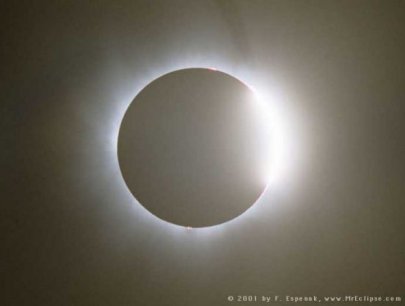 Figure 18. The
diamond ring effect. Only a fraction of the surface of the Sun is
visible here, but it is enough to cast a bright light through the
valleys along the edge of the Moon. Eclipse photograph copyright 2001 by
Fred Espenak courtesy of www.MrEclipse.com.
Figure 18. The
diamond ring effect. Only a fraction of the surface of the Sun is
visible here, but it is enough to cast a bright light through the
valleys along the edge of the Moon. Eclipse photograph copyright 2001 by
Fred Espenak courtesy of www.MrEclipse.com.
You were probably told in elementary school "Don't ever look at a solar eclipse - you'll go blind!" or something like that. That's not entirely true, though you have a pretty good opportunity to really screw up your eyes if you are really stupid. As a general rule you should never stare at the Sun, and most of the time people don't do that. When people hear that there is going to be an eclipse, they get pretty stupid and think "Gosh, I'll have to use my binoculars to see the eclipse!" or "I better get my telescope out to see the eclipse!" No, no, no, no, no! If you look at the sun with binoculars or a telescope at any time, not just when an eclipse is occurring, you will probably permanently damage your eyes. You should never look at the Sun with any sort of instrument that magnifies it. Cameras are also a no-no, since their lenses can magnify the Sun and this is just as bad as using a telescope. Looking at the Sun with binoculars or a telescope is equivalent to frying ants on the sidewalk with a magnifying glass, only in this case, the ants are your eyeballs. Don't do it!
Even if you don't use anything to magnify the Sun, and decide to watch it with your sunglasses, that's pretty stupid as well. Even polarized glasses won't protect you while staring at the Sun. You've probably glanced at the Sun for short periods of time, and you're left with an "afterglow" of its image. If you do that too much, that "afterglow" won't go away - ever. During eclipses people can get proper eye protection to allow them to safely view the Sun. These filtered glasses are available at low cost and provide a safe method of viewing the Sun. You may have heard of other things that can be used, but not all of those things are reliable.
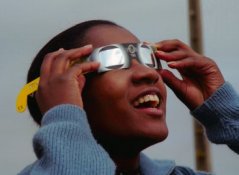 Figure 19. Eclipse
glasses, with special filters, are the best way to view an eclipse
safely.
Figure 19. Eclipse
glasses, with special filters, are the best way to view an eclipse
safely.
Now after all of this stuff about not staring at the Sun, I have to tell you that there is a time when it is okay to look at the Sun with a regular telescope - during totality, when the Moon completely covers up the Sun. At no time before total coverage and at no time after is it safe, only when the surface of the Sun is completely blocked from view. While the surface of the Sun is blocked, it is possible to see the other layers of the Sun's atmosphere, the big fluffy corona and the pinkish chromosphere. Whether you actually see these layers depends upon what the Sun is doing - how "active" it is. People who observe and photograph eclipses are very careful to time their viewing. Usually they find the exact time for the start and finish of totality and use stop watches or alarms to prevent themselves from damaging their eyes. Before totality, they have to use special cameras or telescope filters to view and photograph the Sun safely, but when totality hits, they take these filters off and start snapping pictures like crazy.
Figure 20. A
series of images showing a total solar eclipse. The images are combined
together to show the eclipse in different stages, with totality
occurring in the middle image. Eclipse photograph copyright 2001 by Fred
Espenak courtesy of www.MrEclipse.com.
It is also possible that the Moon's umbral shadow may not even reach the Earth. This will occur when the Moon is slightly further away and its angular size is slightly too small to completely cover up the Sun. In this case, only the penumbra of the eclipse reaches the Earth. This produces an Annular eclipse. A viewer of the eclipse would see the Sun as a ring about the Moon. Click here to see animation of an annular eclipse. There are also eclipses that change from one type to another. These are hybrid eclipses which can start out as an annular eclipse and then become a total eclipse or the other way around. You have to remember that the circumstances for a total eclipse to occur are very precise, and often these conditions can't always be met.
An annular eclipse is a type of partial eclipse, where only part of the Sun is covered up. During a total solar eclipse, you need to be in the path of totality to get the full, dark eclipse. Otherwise, you will only experience a partial eclipse. Only those people who are in exactly the right place at exactly the right time will get to see anything exciting (weather permitting), because of the rather special arrangement for a solar eclipse, especially a total solar eclipse. For this reason, many people will go to a lot of trouble and money to be at exactly the right place to see a total solar eclipse.
Eclipses are amongst the most popular astronomical events for non-astronomers to view and you can spend a lot of money traveling around the world to view various eclipses. There are about two solar eclipses each year, but they are sometimes only partial or annular eclipses. Often the path of totality is over oceans, so it isn't always easy to view them. Figure 21 shows the path of some recent past eclipses and those that are coming up over the next few decades. As can be expected, many of the eclipse paths are located over oceans since the Earth is covered with so much water. A table of upcoming solar eclipses can be found here. If you want to wait for one to come to you, then you have a little bit of a wait. The next total solar eclipse visible from the US will be Aug. 21, 2017. Don't forget that date! It should be a seriously fun time! Here is a website with a great deal of information about the eclipse. To see the total eclipse, you'll have to head south. From UNI it will be only a partial eclipse.
Eclipses of any type are fairly rare since they require a specific set of conditions. And there are quite a few things that factor into eclipses (both solar and lunar eclipses). You have the variation in the distance of the Moon and the Sun from the Earth, and the changing alignment of the Moon's orbit relative to the ecliptic. Eclipses listed in the tables noted above are not very common, with only a handful of eclipses each year. So the next time one is visible from your location, make sure you take the time to view it - you will have to wait a long time for the next one!
| Figure 21. Paths of total solar eclipses are shown (on left) and annular eclipses (on the right). If you click on the image you'll see a larger version of the map. For the total eclipse maps, an observer would have to be located in the dark path to experience a total solar eclipse. To see the Sun "surround" the Moon during an annular eclipse, and observer would have to be located along the paths shown in the map on the righ. Eclipse maps courtesy of Fred Espenak - NASA/Goddard Space Flight Center. For more information on solar and lunar eclipses, see Fred Espenak's Eclipse Home Page: http://eclipse.gsfc.nasa.gov/eclipse.html | |